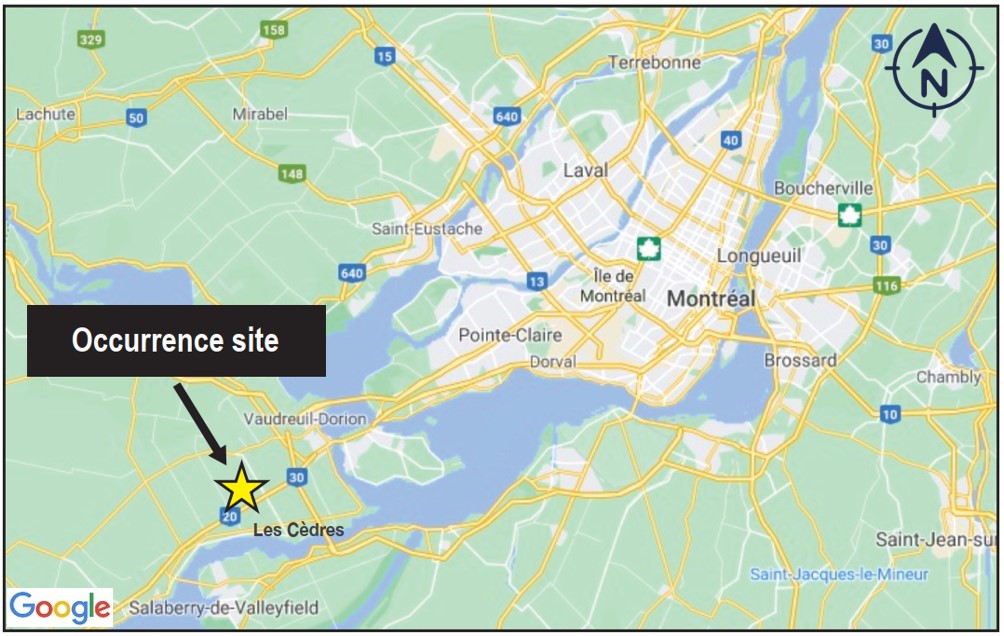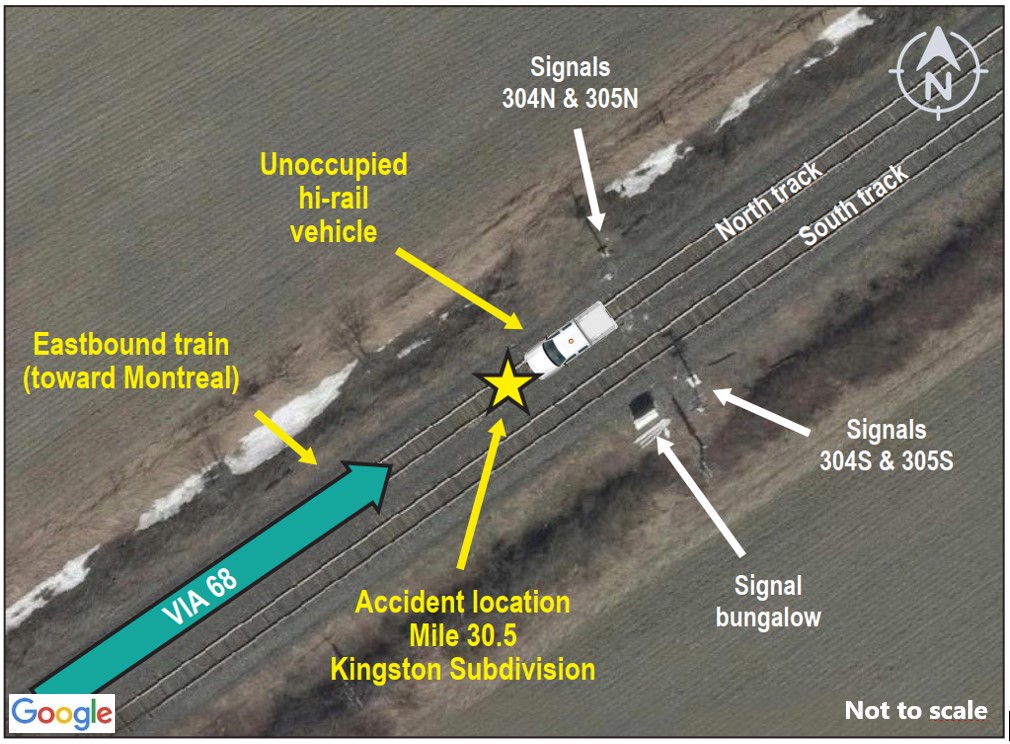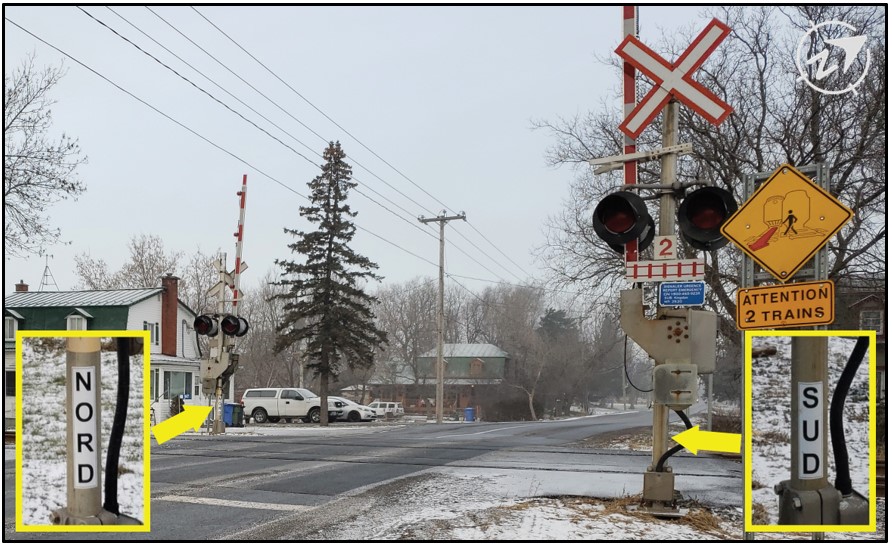Collision between a train and a track unit
VIA Rail Canada Inc. passenger train VIA 68 and
STL 099285 hi-rail vehicle
Mile 30.5, Canadian National Railway Company Kingston Subdivision
Les Cèdres, Quebec
The Transportation Safety Board of Canada (TSB) investigated this occurrence for the purpose of advancing transportation safety. It is not the function of the Board to assign fault or determine civil or criminal liability. This report is not created for use in the context of legal, disciplinary or other proceedings. See Ownership and use of content. Masculine pronouns and position titles may be used to signify all genders to comply with the Canadian Transportation Accident Investigation and Safety Board Act (S.C. 1989, c. 3).
The occurrence
On , VIA Rail Canada Inc. (VIA) passenger train VIA 68 was travelling from Toronto Union Station, Ontario, to Montréal Central Station, Quebec. The train consisted of lead locomotive VIA 911 (the locomotive), 5 passenger cars, and tail-end locomotive VIA 6413. There were 43 passengers on board. The train was about 553 feet long and weighed approximately 551 tons.
The train crew comprised an operating locomotive engineer and an in-charge locomotive engineer. Both were qualified for their respective positions, met rest and fitness standards, and were familiar with the territory. A service manager and a senior service attendant were stationed in the passenger cars.
At about 2132,Footnote 1 the train was travelling east at the authorized speed (95 mph) on the north main track of the Canadian National Railway Company (CN) Kingston Subdivision. As the train approached Mile 31, the 2 engineers on board the locomotive noticed a bright light in the distance. When the operating locomotive engineer realized that the light appeared to be coming from rolling stock on the same track as the train, he immediately initiated a full service air brake application and sounded the locomotive horn and bell. A few seconds later, the train, still traveling at nearly 83 mph, struck a pick-up truck type hi-rail track unit (STL 099285) at Mile 30.5, in the municipality of Les Cèdres, Quebec (Figure 1).
Following the impact, the operating locomotive engineer initiated an emergency brake application. The locomotive dragged the hi-rail track unit approximately 2500 feet before the train stopped. There were no injuries, and no fuel was spilled.
At the time of the collision, the hi-rail track unit was unoccupiedFootnote 2 and stationary on the north track, just west of intermediate signals 304N and 305N (Figure 2). Its headlights, fog lights, and strobe lights were on, in accordance with CN requirements,Footnote 3 and its engine was running.
The train crew immediately informed the rail traffic controller (RTC), who contacted emergency services. The passengers remained on board the train and were attended to by emergency services and VIA personnel. A relief crew then conducted the train, which arrived at Central Station around 0415.
At the time of the occurrence, the sky was overcast and visibility was good. It was −3 °C and winds were from the west at approximately 17 km/h.
Subdivision information
The Kingston Subdivision extends from Mile 10.3 (Dorval East, Quebec) to Mile 333.8 (Toronto, Ontario). The track in the vicinity of the collision consists of double main track, designated as North Track and South Track, in accordance with Rule 81 of the Canadian Rail Operating Rules (CROR). Train movements are governed by the centralized traffic control system (CTC), in accordance with the CROR, and are supervised by a CN RTC located in Edmonton, Alberta.
Centralized traffic control system
In a CTC system, trains operate by following the indications of signal lights along the railway, while RTCs follow, on screen and in real time, the movements of trains in the blocks and controlled locationsFootnote 4 in their area. The movements of track units on tracks are protected by measures set out in the regulations, such as track occupancy permits (TOP). TOP limits are displayed on RTCs’ CTC screens; however, RTCs cannot follow track units in real time, because the units do not activate the signal system.Footnote 5 As a result, RTCs cannot determine whether track units are on the track outside their limits of authority based only on what they see on the screen.
Protection of ongoing work in the Kingston Subdivision
The signal maintainer, who had more than 5 years of experience, was performing maintenance work on signal equipment in the Kingston Subdivision. He reported to a foreman, who was responsible for the coordination of the work and the protection of track work.
Around 2050 on the evening of the occurrence, through the ETOP system,Footnote 6 the foreman obtained 2 TOPs for the Kingston Subdivision, between the Coteau Est and Caron controlled locations: TOP 9687 for the south track and TOP 9689 for the north track.
The foreman sent the maintainer an electronic copy of TOP 9687, but did not read its content aloud as required by Rule 855 of the CROR.Footnote 7
Vehicle on the railway
Around 2100, the maintainer went to the Saint-Féréol Road grade crossing. The grade crossing is equipped with automatic warning devices.Footnote 8 The 2 tracks are identified by “NORD” and “SUD” stickers on the signal masts (Figure 3).Footnote 9 The volume of road traffic on this secondary road is considered low.
It was dark, and the area was lit only by a street lamp just over 50 feet southwest of the grade crossing. The signal maintainer intended to put his vehicle on the south track and move westward, but inadvertently positioned the vehicle on the north track and exited, lowering the front and rear guide wheels of the hi-rail system. Once the vehicle was positioned on the track, the signal maintainer moved westward to the signal bungalow, located just over a mile away. During this time, the signal maintainer did not notice the “NORD” and “SUD” stickers on the signal masts. These stickers are used to indicate to hi-rail track unit operators which track they are travelling on.
Cancellation of the north track occupancy permit
TOP 9689 (for the north track) had to be cancelled by the foreman to allow an approaching VIA train to proceed eastward. Even though he was not required to, the foreman phoned the signal maintainer before cancelling TOP 9689. The signal maintainer assured him that he was clear of the north track. Around 2121, the foreman cancelled TOP 9689 using the ETOP system, clearing the north track for the VIA train to proceed.
Signal maintainer’s work schedule
The railway signal upgrade in the Kingston Subdivision was a major project, requiring employees to work overtime and at night.
Hours worked in addition to a 40-hour work week, particularly if combined with reduced sleep, are linked to an increased risk of workplace injuries.Footnote 10 According to one study that examined injuries in manufacturing workers,Footnote 11 people who work more than 64 hours in the week prior to their shift have an 88% excess risk of accidents than people who work 40 hours a week or less. The study concluded that the control of overtime in the manufacturing industry may reduce the risk of worker injury.Footnote 12
Track maintenance stations, including the signal maintainer’s track maintenance station, are governed by the Canada Labour Code (CLC). Under Part III of the CLC, employees are limited to a maximum of 48 hours of work per week. The CLC includes provisions for an employer to apply for a permit to exceed the maximum hours of work specified. CN had applied for and obtained such a permit, which was in effect from 01 January to 31 December 2020. It allowed certain employees, including the signal maintainer, to work up to 39 overtime hours per 2-week period (totalling a maximum of 135 hours), and to work up to 8 consecutive days, followed by 6 days off.
The maintainer’s schedule varied somewhat, but each day usually began around 2000 and ended around 0600 or 0700. In the past 6 weeks, he had worked at night for an average of 52 hours a week. On the day of the occurrence, it was his 8th consecutive work day; at the beginning of his 8-hour shift, he had accumulated a total of 70 work hours since his last full day off. He had worked 54 hours the previous week and a total of 24 hours since 04 December, which was the beginning of his work week.Footnote 13 These hours were compliant with the provisions of the permit granted to CN, which allowed him to work up to 81 hoursFootnote 14 in the week ending on 10 December.
Night work presents additional challenges in terms of fatigue management. Night shift workers report worse sleep quality and decreased alertness than what they observe during day shifts.Footnote 15 Night shifts (as opposed to day shifts) and long working hours (12 hours or more) are the main risk factors for severe sleepiness among people working several consecutive shifts.Footnote 16
On the day of the occurrence, the signal maintainer began his shift earlier than usual, around 1800, at the CN Southwark rail yard in Longueuil, Quebec. His regular schedule had been changed slightly when his supervisor asked him that evening to replace an absent employee.
An analysis using the Fatigue Avoidance Scheduling Tool (FAST)Footnote 17 was completed in the course of the investigation to assess the fatigue of the signal maintainer in this occurrence. From this analysis, it was determined that, when the signal maintainer arrived at Les Cèdres around 2030, he had probably accumulated a sleep debt, a condition that contributes to fatigue, given his numerous consecutive night shifts involving long hours and the fact that he was sleeping during the day, when quality of sleep is reduced.Footnote 18
The risks associated with fatigue include lapses in judgement and decreased situational awareness. To counter the physiological effects of fatigue, administrative means of defence can be used, such as briefing sessions on the work to be performed and notifications regarding operational limitations being written out and read out loud.
TSB Watchlist
The TSB Watchlist identifies the key safety issues that need to be addressed to make Canada’s transportation system even safer. Fatigue management has been a Watchlist issue since 2016. As this occurrence demonstrates, work schedules that increase the risk of fatigue in railway employees such as the signal maintainerFootnote 19 may create high-risk situations with potentially serious consequences. The TSB will continue to monitor and assess fatigue management.
Other occurrences involving track units
Since 2011, the TSB recorded 240 collisions in Canada involving track units on the railway, in which 31 employees were injured.Footnote 20 Of those 240 collisions, 53 occurred with a train. And of those 53 collisions, 25 occurred on signalled territory. A total of 178 of the 240 collisions occurred on the main track, and 18 of those were movements exceeding their limits of authority.
Safety action taken
On 15 December 2020, TC sent a notice to CN indicating that the measures implemented to prevent events such as this occurrence had been deemed insufficient.
On 06 January 2021, CN informed TC that it had developed an employee assessment tool to check their knowledge of the regulations governing the protection of track work.
Safety messages
Employees’ vigilance may decrease if they work long hours in the evening and at night for multiple consecutive days. To prevent employee fatigue or inattention from contributing to occurrences like this one, rail companies should consider implementing physical defences such as devices that enable RTCs to detect the position of track units on the track.
This report concludes the Transportation Safety Board of Canada’s investigation into this occurrence. The Board authorized the release of this report on . It was officially released on .


